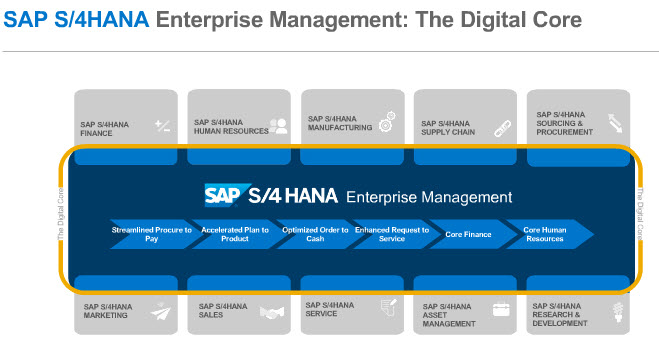SAP’s Carl Dubler provided this webcast today. Recording is available here: https://sap.na.pgiconnect.com/p1i8wxgr550/
Carl asked us to guess what was the number one question received:
#2 question is about custom development
#1 question – what is S/4HANA and Suite on HANA

Figure 1: Source: SAP
Carl’s non-official opinion is shown in Figure 1
HANA – High performance analytical appliance
In 2012, started putting BW on it
In 2013, ran OLTP as well
In 2014, Simple Finance
Aggregates removed, indices being removed
November 11, Barcelona – include rest of ERP “digital core”

Figure 2: Source: SAP
Before had an add-on strategy, not using that anymore
Now “at parity” with ERP 6 and run in one core in November 2015

Figure 3: Source: SAP
We see this slide a lot
“Digital core” in the middle “Enterprise management” – key ERP functions in middle, crossing lines of business
Finance – accounting & financial core – others, like cash management, not part of it
“Full core available, upgrade directly to, without add-on, all lines of business”
Will see more details emerge
“The way I interpret this is that each of the grey boxes need additional licensing” – one attendee said, speaker confirmed

Figure 4: Source: SAP
Industries are still working on, like retail

Figure 5: Source: SAP
Key innovations
Different business functions listed
Core modules, applications
“Innovation” is the buzzword used more and more versus simple – simple will go away from product view – no “Simple Finance” but S4/Finance

Figure 6: Source: SAP
Simplification – cut out postal service entirely
S4/HANA and Suite on HANA analogy explained
Run suite on new DB – Suite on HANA
Bottom – S4/HANA – change architecture

Figure 7: Source: SAP
Simple Finance followed the same principles for elimination of aggregate tables resulting in one physical document. “Material Ledger will also be redesigned”

Figure 8: Source: SAP
Inventory tables down to 3, removing the need for aggregates

Figure 9: Source: SAP
This blog was mentioned in the chat: SAP HANA Explained - Again
More reliability for IT with less storage

Figure 10: Source: SAP
CDS views are there for compatibility
Transactions may be going away
Conversations about customer code
Simplification database – Frank Wagner’s blog – tools on SMP - blog: Upcoming Tools for SAP #S4HANA Migration – the simplification database
More details in this Document: The road to SAP S/4HANA: the different transition paths The road to SAP S/4HANA: the different transition paths created by Frank Wagner

Figure 11: Source: SAP
Equation is shown above, includes simpler data model (fewer tables) and UX with Fiori combined
Links: https://www.s4hana.com/
Trial Editions: http://www.sap.com/s4hana-trial
Use cases: http://scn.sap.com/community/s4hana/blog/2015/07/13/s4hana--the-use-case-series--intro

Figure 12: Source: SAP
Finance can “close books any time they want”

Figure 13: Source: SAP
New in 1511 release
Consistent view of data
Don’t need to wait for batches to run

Figure 14: Source: SAP
Don’t need to create duplicates for reporting
MRP runs are faster, companies are running them several times a day

Figure 15: Source: SAP
Asks of customers
Interview with Convergent: http://searchsap.techtarget.com/news/4500253346/How-to-decide-when-to-move-to-SAP-S-4HANA

Figure 16: Source: SAP
How do this?
New implementation: New SAP customer who want to move from legacy systems to SAP
System conversion (ECC 6 to S/4HANA): Existing SAP Business Suite Customer who wants to move to SAP S/4HANA
System consolidation is an option (Central Finance)

Figure 17: Source: SAP
Use SLT to bring over
Central Finance book: https://www.sap-press.com/sap-simple-finance-how-do-i-get-started-without-migrating_3937/

Figure 18: Source: SAP
If you are doing a system conversion look at the above

Figure 19: Source: SAP
Learn about ACTIVATE

Figure 20: Source: SAP
On the left, SAP has created a database of “simplification database”
Tools to run to check custom code, compares to simplification database, and tells you the notes
Thanks to Carl for a great webcast (watch the recording for the MRP demo) and thanks to chris.kernaghan for hosting
